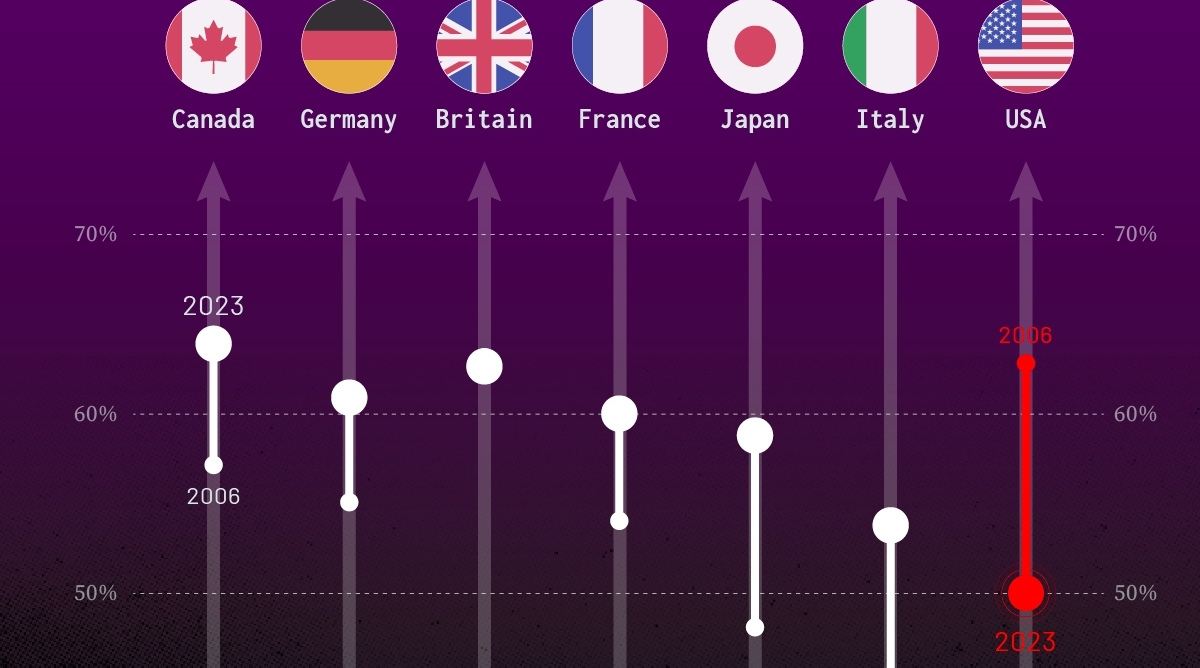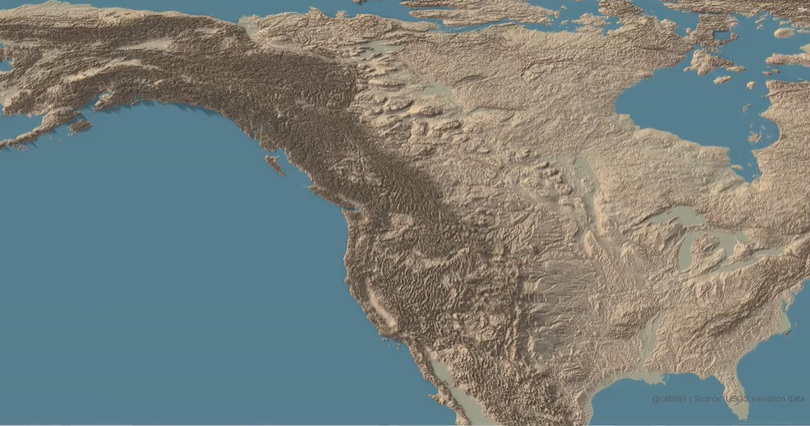Misc
Mapped: The United States of Elevation
Mapped: The United States of Elevation
If you contrast the world’s mountains to the actual size of the Earth, they are just tiny bumps.
In fact, if you had a globe that was 12-inches in diameter with mountains accurately depicted to scale, Mt. Everest would protrude from the surface at just the thickness of two sheets of paper.
But while these rocky formations seem insignificant from the vacuum of space, for us that live on Earth they are much more relevant. Mountains dictate everything from weather patterns to travel routes, and these geographical features have helped shape human society as we know it.
Elevation, Exaggerated
Today’s short video loop comes from Reddit user newishtodc, and it shows the elevation profile of most of the continental United States.
Pulling data from the USGS, the video loop actually exaggerates the scale of the topography so that elevation changes are much more pronounced. Instead of getting the “bumps on a surface” effect, it allows us to clearly see where the mountainous regions are.
Here’s another version, this time including Alaska, Canada, and parts of Mexico:
Peak Elevation
As you likely noticed in both videos, mountains are particularly abundant on the western side of the continent.
What you may not have realized, however, is that the highest peaks in North America are exclusively found in just three different subregions: Alaska (U.S.), Yukon (Canada), and the Cordillera Neovolcanica (Mexico).
The 10 Highest Peaks in North America
| Rank | Mountain | Location | Range | Elevation |
|---|---|---|---|---|
| #1 | Denali | 🇺🇸 Alaska | Alaska Range | 20,310 ft (6,190 m) |
| #2 | Mount Logan | 🇨🇦 Yukon | Saint Elias Mountains | 19,551 ft (5,959 m) |
| #3 | Pico de Orizaba | 🇲🇽 Mexico | Cordillera Neovolcanica | 18,491 ft (5,636 m) |
| #4 | Mount Saint Elias | 🇺🇸 Alaska | Saint Elias Mountains | 18,009 ft (5,489 m) |
| #5 | Popocatépetl | 🇲🇽 Mexico | Cordillera Neovolcanica | 17,749 ft (5,410 m) |
| #6 | Mount Foraker | 🇺🇸 Alaska | Alaska Range | 17,400 ft (5,304 m) |
| #7 | Mount Lucania | 🇨🇦 Yukon | Saint Elias Mountains | 17,257 ft (5,260 m) |
| #8 | Iztaccíhuatl | 🇲🇽 Mexico | Cordillera Neovolcanica | 17,159 ft (5,230 m) |
| #9 | King Peak | 🇨🇦 Yukon | Saint Elias Mountains | 16,972 ft (5,173 m) |
| #10 | Mount Bona | 🇺🇸 Alaska | Saint Elias Mountains | 16,550 ft (5,044 m) |
The highest mountain on the continent is Denali—although you may know it as Mt. McKinley. The name change was actually requested by Alaska back in 1975, but it wasn’t officially recognized by the U.S. government until 2015, coinciding with President Obama’s visit to the state.
Denali isn’t the only massive mountain in Alaska, and the state is actually home to all 10 of the highest peaks found in the United States.
The tallest mountain in California (Mt. Whitney, 14,505 ft) comes in at #11 on the U.S. list, while Colorado’s highest (Mt. Elbert, 14,440 ft) comes in the #14 spot nationally. Finally, the highest peak in Washington State (Mt. Rainier, 14,417 ft) is at #17.
Flatter Than a Pancake?
In the above animations, it’s also possible to see the regions that are dead flat.
Despite having a reputation for being flatter than a pancake, Kansas isn’t anywhere near the flattest state. That particular designation goes to Florida, where the top elevation is just 345 ft (105 m) above sea level.
Strangely, Florida is so flat that many of the tallest buildings in Miami easily surpass the highest natural point in the state in terms of height. The Panorama Tower, for example, is 868 ft (265 m) tall, making it more than double the height of the highest hill in Florida (Britton Hill).
Politics
Charted: Trust in Government Institutions by G7 Countries
How much do you trust the government and its various institutions? We look at data for G7 countries for the time period of 2006-2023.

Trust in Government Institutions by G7 Countries
This was originally posted on our Voronoi app. Download the app for free on iOS or Android and discover incredible data-driven charts from a variety of trusted sources.
How much do you trust the government, and its various institutions?
It’s likely that your level of confidence probably depends on a wide range of factors, such as perceived competency, historical context, economic performance, accountability, social cohesion, and transparency.
And for these same reasons, trust levels in government institutions also change all the time, even in the world’s most developed countries: the G7.
Confidence in Government by G7 Countries (2006-2023)
This chart looks at the changes in trust in government institutions between the years 2006 and 2023, based on data from a multi-country Gallup poll.
Specifically, this dataset aggregates confidence in multiple national institutions, including the military, the judicial system, the national government, and the integrity of the electoral system.
| Country | Confidence (2006) | Confidence (2023) | Change (p.p.) |
|---|---|---|---|
| Canada | 57% | 64% | +7 |
| Britain | 63% | 63% | +0 |
| Germany | 55% | 61% | +6 |
| France | 54% | 60% | +6 |
| Japan | 48% | 59% | +11 |
| Italy | 41% | 54% | +13 |
| United States | 63% | 50% | -13 |
What’s interesting here is that in the G7, a group of the world’s most developed economies, there is only one country bucking the general trend: the United States.
Across most G7 countries, confidence in institutions has either improved or stayed the same between 2006 and 2023. The largest percentage point (p.p.) increases occur in Italy and Japan, which saw +13 p.p. and +11 p.p. increases in trust over the time period.
In the U.S., however, confidence in government institutions has fallen by 13 p.p. over the years. What happened?
Key Figures on U.S. Trust in Institutions
In 2006, the U.S. was tied with the UK as having the highest confidence in government institutions, at 63%.
But here’s where the scores stand in 2023, across various institutions:
| 🇺🇸 Institutions | Confidence (2023) |
|---|---|
| Military | 81% |
| Judiciary | 42% |
| National Government | 30% |
| Elections | 44% |
| Overall | 49% |
Based on this data, it’s clear that the U.S. lags behind in three key indicators: confidence in the national government, confidence in the justice system, and confidence in fair elections. It ranked in last place for each indicator in the G7.
One other data point that stands out: despite leading the world in military spending, the U.S. is only the third most confident in its military in the G7. It lags behind France (86%) and the United Kingdom (83%).
-

 Wealth6 days ago
Wealth6 days agoCharted: Which City Has the Most Billionaires in 2024?
-

 Mining2 weeks ago
Mining2 weeks agoGold vs. S&P 500: Which Has Grown More Over Five Years?
-

 Uranium2 weeks ago
Uranium2 weeks agoThe World’s Biggest Nuclear Energy Producers
-

 Education2 weeks ago
Education2 weeks agoHow Hard Is It to Get Into an Ivy League School?
-

 Debt2 weeks ago
Debt2 weeks agoHow Debt-to-GDP Ratios Have Changed Since 2000
-

 Sports2 weeks ago
Sports2 weeks agoThe Highest Earning Athletes in Seven Professional Sports
-

 Science2 weeks ago
Science2 weeks agoVisualizing the Average Lifespans of Mammals
-

 Brands1 week ago
Brands1 week agoHow Tech Logos Have Evolved Over Time















